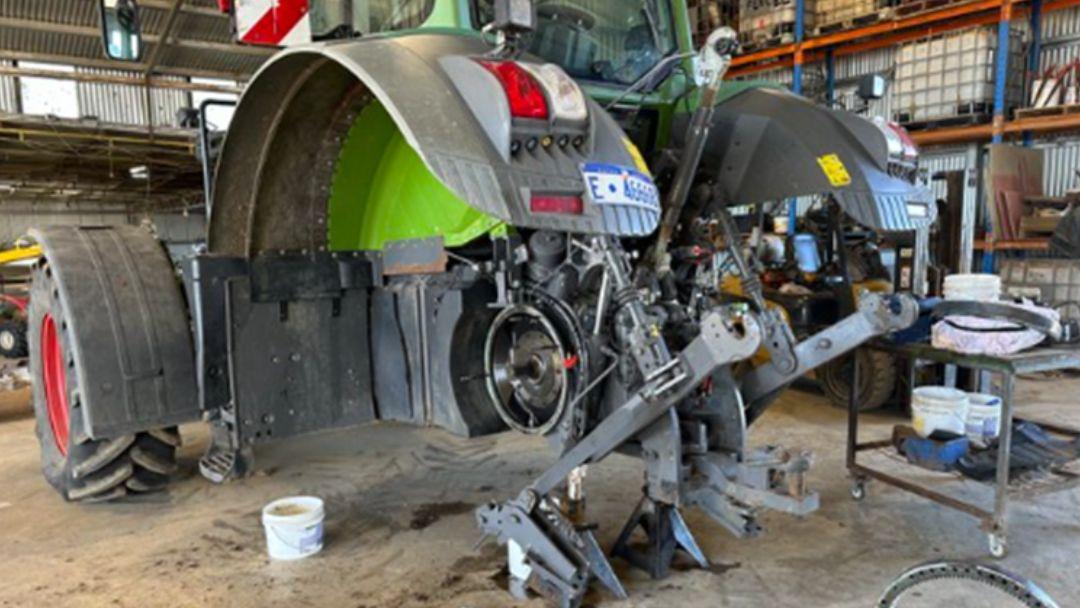Michael Hart recently tweeted a nice photograph of a light green tractor with its rear axle pulled down for bearing replacement with the tongue-in-cheek comment “I don’t know how much money I’ve made from CTF, but I know how much I’ve spent” – obviously on equipment repairs. This is the backstory to Michael’s tweet.
History
Michael and his wife, Catherine, farm in Dalyup, on the sandplain 50 km north-west of Esperance. The transitional mallee begins between his farm and the next road, so in his own words: “We would be considered to be at the top of the stocking area and the bottom of the cropping”. They have concentrated on cropping predominately since he starting farming in 2005.
Michael is a second generation farmer, his father having cleared the land after arriving in 1964, running a farm focused on wool with a one-in-three cropping rotation with pastures. Following the collapse of wool in the 1990s more land was purchased and cropping increased, with canola being the rotational break crop of choice because they had no viable legume or alternative. They started growing canola in 1993, skipped 1994 due to drought, but haven’t missed a year since. In the early 2000s Hybrid canola allowed the commencment of a canola-cereal rotation.
The CTF System
When Michael went farming on his own in 2005 he began to purchase his own equipment. CTF was the new idea back then and made sense, so he initially began to build a 100% matched system based on a 30 ft module. This had two major problems: the imperial measure, which meant many harvester fronts didn’t fit (MacDon was metric but HoneyBee wasn’t); and 30 feet was too small for critical operations like seeding.
After only a couple of years Micheal made the shift towards his current 12/36 m system, but this also has some engineering challenges – particularly spreading lime, urea and straw. It was also expensive. You can’t change the header track width, so other equipment must be upgraded to match that dimension. The 12/36 m system was essentially complete by 2012, with a few compromises e.g. inadequate header auger length meant having to fill the nearside of chaser bins first, then move closer to the harvester to top up with only one side of the tractor and bin on the trams.
Michael believes the CTF system is a net benefit, and has anecdotal evidence to favour it. Clearly there is a fuel saving: if he pulls his 300 hp (225 kW) spray tractor off the trams – often needed on headlands to put the boom over the fence – the tractor struggles to have enough power. In his second year with the matched system, flooding summer rains delayed the start of spraying by 10 days. When Michael started spraying, he remembers coming down a paddock and finding a two hectare lake. In his words, he “started to skirt around it but sank like a stone until I turned back onto the tram, after which it went through the puddle like I was on a road (I was on a road). That ticked a box for me.”
In recent years Michael has bought a high horsepower rubber-track Fendt for deep ripping and seeding. Its excessive for his DBS seeding system but the surplus power allows him to use 9” (23 cm) points and get power through to the narrow track. The bigger tractor will also work through the small areas of heavy soil where the older tractor would at best slow down or at worse be forced to reduce depth. They’ve also had a series of dry starts where even the DBS struggles to penetrate all soils.
Maintenance costs
Michael’s bill for maintenance on the 930 Fendt FWA was for some bearings (that didn’t come from Fendt) but still came to almost $7k (inc GST), at 3500 hours of service. This was for the back end, which can be monitored simply by checking bearing preloads, so the issue can be dealt with before causing major damage. This simple check won’t work with the front-end of FWA’s, where oil sampling and observation are the only tools to prevent a disaster.
Michael nearly had this disaster on a previous FWA, a John Deere 8130. One morning during harvest he happened to walk around this tractor when he noticed a change in the gap between the hub and the spacer – bearing failure was imminent! The tractor was being operated by a backpacker, who wouldn’t have picked it up, and this would have been very expensive if that hub had failed and the wheel fell off. Picking it up early meant that the cost was just for all bearing replacement, and the damaged stub was dressed to keep it in service.
This certainly emphasises the value of checks such as bearing preload and oil sampling. Unless a purpose-built front axle is bought, the 3 m track width of CTF means that wheels are moved away from the bearings supporting them. This increases bearing loads and tends to reduce bearing life.
Problems with CTF
Michael is concerned about the inability to spread straw and lime across his chosen width (12 m). If they consistently fail to do these spreading tasks properly, then over time the missed areas will change significantly and degrade and there will be no way to rectify the situation. It is the area midway between the tramline runs that is the most vulnerable on the farm because it is unfairly neglected.
Michael’s other whinge with CTF is the roughness of the paddocks. “I have tramline renovated, but second headland runs of the boom are terrible where the main runs intersect the headland. If tramline renovation is done, and a wet year follows, it makes it worse. Its been ameliorated a little this year by stepping the sprayer across to a less used tram till the main one settles down a bit – but it’s also been a dry year so that helps”.
The farm is rough and Michael sees no way of returning it to the smooth paddocks they used to have. And it’s a serious problem if a fire truck was to come into the paddock, they have to contend at times with this roughness. He also misses being able to simply cross sow his paddocks, seeing it happen elsewhere with great success.
Michael tries to put seed in last year’s row precisely, using RTK on the tractor. He says “It can be a bit hit and missI – I have a paddock, largely sown by a less experienced operator that is one of the worst germinations of canola I’ve seen. It’s a Roundup ready IMI variety, and I didn’t have sufficient seed to resow, so it’s the worst paddock on the farm for weeds, and they love the lack of competition”. He will “chaffline” and burn the windrows of chaff and seed in that paddock this year to help deal with that problem. Micheal also had to realign a paddock this year to incorporate a new runline and can now see the flowers emerging on the intersection of the seed rows. This potentially could add up to serious competition and loss of profit. Precision must drive the system.
Reflections
Michael says he started out as a CTF perfectionist – but he’s chilled a bit over the years. “I’ve watched neighbours farm successfully without CTF and have some unique advantages – e.g.cross sowing. I’ve also practiced HWSC nearly every year and yet my neighbours who haven’t done anything with harvest weed seed control still farm well.
All that said, I think the worst we could do is buy a tractor on triples, put a, RTK dome on top and proceed to compact the same wide wheel track, year after year by precisely driving in the same location. Either we control the traffic or make it truly random traffic to spread that load across the entire landscape”.
Micheal concludes on a philosophical thought: “I’ve heard it said that a farmer gets 34 seasons before they retire. I’m only around 20 seasons in and I’ve got a red-hot son rising with another coming behind him, both wanting to farm. Our task often in farming is to recognise patterns and engineer solutions and teach these to the next generation. I suspect I’ve only got 5 years before they largely take over and hopefully they have the wisdom to observe the patterns, and the humility to make changes when their ways don’t work out”.

